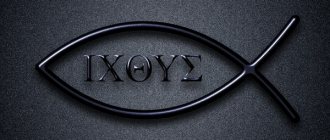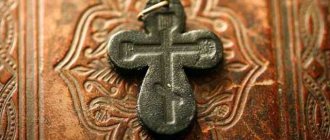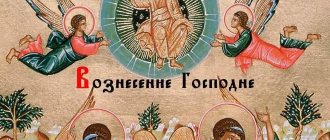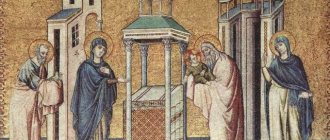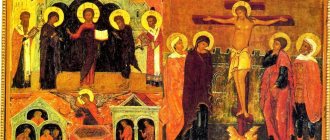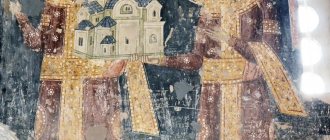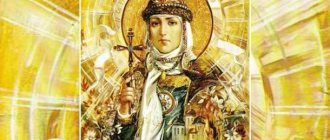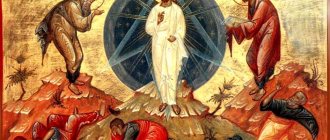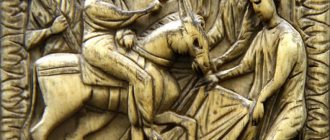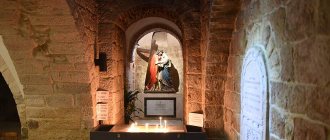What do we know about the holiday
Date of: 21
April
Status:
twelfth holiday
Event:
The Entry of the Lord into Jerusalem (Palm Sunday) is a holiday on which the Orthodox Church remembers one of the most important events in gospel history (Matt. 21
).
In the spring of 30 AD, pilgrims flocked to Jerusalem from all sides to celebrate the main religious holiday - Passover (Old Testament Easter). Christ also goes here with his disciples.
The news of the resurrection of Lazarus had already spread through the streets of Jerusalem. The high priests, angered by the growing popularity of Christ, began to think about how to destroy Him and Lazarus. But while some were plotting murder, others came out to meet the Savior approaching the city.
Many hoped that Christ would enter Jerusalem to end the humiliating Roman occupation, that He would ascend to the royal throne and restore the Jewish state to its former glory and power. Imagine everyone’s surprise when Christ rode into the city gates not on a war horse, as befitted a formidable liberator, but on an ordinary donkey. Thus, the Lord once again showed that the Kingdom that He wants to establish is “not of this world.”
The streets are drowning in general rejoicing: huge crowds of people greet Christ as king and Messiah. They spread palm branches and their clothes before him, shouting: “Hosanna! Blessed is he who comes in the Name of the Lord, the King of Israel!” (“Hosanna” means “Save us”). Who would have thought that within a few days these same people would be shouting “Crucify Him!” in the courtyard of the Roman prefect of Judea, Pontius Pilate.
Holiday date in 2022
Palm Sunday in 2022 falls on April 25 (April 12, old style).
The sixth, flower-bearing week of Lent (week of Vai)
Readings of the day in churches:
- At the morning service the Gospel of Matthew is read (21:1-11,15-17)
- At the liturgy: Gospel of John (12:1-18)
Palm Sunday, for obvious reasons, is a holiday, a celebration. But, coming to the temple with willows, everyone should ask himself: “What did I bring to my God?” After all, from the context of church books, willows are just a sign of those fruits, spiritual virtues that we must bring to God, finishing our penitential work. And while carrying these fluffy willows, we must ask ourselves: “what else did I bring to God, what did I acquire, what did I learn, what did I learn, what was I able to do, why did I spend this fast, did it leave a mark on my life?” "?
Having overcome these six weeks, I remember what happened. How a sailor remembers the past expedition. Yes, I have understood a lot and will never go back to the old ways, may God help me. Everyone should understand that the real true virtue of a Christian will be humility and the mercy that accompanies it. If we see, going to the temple, that all the people walking with us, all the people standing in the temple with us are better than us... And we are glad that they are standing with us, and tears flow from our eyes, because we see brothers and sisters rejoicing with us, it means we didn’t spend this fast in vain. And if we are gloomy, offended, if we are irritated, then this willow that we are carrying is of no use.
Priest Konstantin Korepanov
Entry of the Lord into Jerusalem. At this moment, people accept Christ with joyful exclamations, people expect to see in him an earthly king, a messiah, and therefore they take off their outer garments, lay them under Jesus’ feet and cut off palm branches. In ancient times, only kings were greeted this way. We, having no palm branches, meet Christ with the first fresh shoots of reviving trees, namely the willow. And we also celebrate Palm Sunday with special solemnity, but we know that behind this joy there is also a special sorrow for each of us, for the Lord, because of our sins and for the sake of our salvation, goes to free suffering.
Holiday icon:
In the center of the icon is Christ Himself.
He sits sideways on a donkey and with a movement of his right hand blesses the people who come out to meet Him.
On the left are the apostles,
They talk embarrassedly, not understanding why their Teacher needed to enter the capital so solemnly.
On the right of the icon are the residents of Jerusalem and guests,
who arrived for Easter. In their hands they hold palm branches - a symbol of triumph with which the Jews greeted triumphants.
The lower part of the icon depicts children spreading their clothes under the donkey’s feet - this is how the Jews greeted those anointed for the kingdom, and the God-Man, according to Christian theology, is the Anointed One for the Kingdom of God.
Mount of Olives
Here Christ talks to his disciples a few days before his arrest (Matt. 24
), and later - will ascend to Heaven (Acts
1
). The mountain on the icon symbolizes the spiritual ascent of the apostles. In addition, in relation to the Savior Himself, the mountain, as an elevated place, indicates His Divine descent to earth for the sake of making an atoning sacrifice, that is, accepting death on the cross.
Donkey
on which Christ entered Jerusalem, carries several symbolic meanings. So, on the one hand, he points to the peaceful nature of the coming Kingdom of God and the meekness of His King - the God-Man. On the other hand, Blessed Theophylact of Bulgaria notes: “The prophecy is He (that is, Christ. - Ed.
.) fulfills both in the historical and in the mysterious sense: in the historical sense through the fact that he visibly sat on a donkey, in an allegorical way - by sitting on a donkey’s colt, that is, on a new, unbridled and rebellious people, the pagans.” That is, the saint emphasized that the image of the donkey saddled by the Savior indicated the future conversion of the pagans to Christ.
Children laying out clothes
at especially solemn moments on the path along which the king goes, is recorded in the Old Testament. So, for example, when the prophet Elisha anointed Jehu as king, his servants each took their clothes, spread them on the very steps, and blew the trumpet, and said:
Jehu reigns!
(2 Kings
9:13
).
Palm branch
for the Jewish people it symbolized fun and celebration. On the first day take for yourselves branches of beautiful trees, branches of palm trees, branches of broadleaf trees and willows, and rejoice before the Lord your God for seven days.
(Lev
23:40
).
When the high priest Simon liberated Jerusalem from the pagans, he was greeted with palm branches as a winner (1 Macc 13:51
).
That is why the holiday of the Entry of the Lord into Jerusalem is also called Palm, or Palm, Sunday
(Week Week).
Folk customs and signs on Palm Sunday
Russian folk customs and beliefs are closely connected with all church holidays. And even though these customs are often not regulated by Orthodox canons and live, as it were, in parallel with them, their history dates back centuries and therefore they are worthy of respect and mention. Palm Sunday is no exception in this regard.
On this day, it is customary to consecrate willow branches in churches. It is believed that a bouquet made from them protects the home from fire, and household members from the negative influence of ill-wishers. In Orthodoxy, the holiday is associated with the Entry of Jesus into Jerusalem, where residents greeted him with palm branches. The exotic tree does not grow in all countries, so it is customary to use the branches of plants that bloom first in the spring. Willow is associated with renewal and the beginning of a new life.
The customs of the holiday were formed in ancient times. It is celebrated in a calm home environment. Believers visit the temple, devote a lot of time to prayers, and consecrate branches. Returning from church, they jokingly whip everyone in the household with branches. It is believed that this grants health for the whole year.
Willow branches were also used to drive unruly livestock out to pasture; after that, willow branches were stuck under the roof of the barn so that the animals would always find their way home. To protect against disease, consecrated willow buds were swallowed. This action brings good luck, as well as hope for success in new endeavors.
To ensure the birth of healthy offspring, twigs were placed under the mattress, and the bride and groom were showered with willow buds. For headaches they inserted blessed twigs into their hair.
What not to do on Palm Sunday
You cannot do any work on this holiday. Housewives try to prepare all dishes in advance. Rich food is not approved; traditionally, various lean dishes and fish are served at the table. You are allowed to drink a couple of sips of red wine.
Folk signs
Peasants have long taken note of the weather to create a sowing calendar and determine how productive the year will be. If the day turns out to be warm and sunny, then the summer will pass calmly, without droughts or cold snaps. Therefore, the likelihood of obtaining a rich harvest increases. Windy weather will bring colder temperatures. The absence of frost promises an abundance of fruit. A chilly but clear day is a sure sign of a spring crop harvest. If there is no snow left on the roofs, May is expected to be hot.
There are other signs. For example, feeding birds on this day means attracting wealth. Another way to improve your material well-being is to plant a new flower.
Palm Sunday is a bright holiday with notes of sadness, which always symbolizes revival and hope in our all-powerful Lord and Savior.
Interesting Facts
What does "Hosanna" mean?
Click to flip
“Procession on a Donkey” - how is it?
Click to flip
Through what gate did Christ enter Jerusalem?
Click to flip
Why is it a willow, and when is it consecrated?
Click to flip
Share the result:
Please share this quiz to view your results.
Prayer
Lord Jesus Christ our God, seated in the highest with the Father on the Throne, carried on wings by the Cherubim and sung by the Seraphim, in the days of His flesh the donkey will sit on the lot of for the sake of salvation, and from children the chanting was received in the Holy City of Jerusalem first six days of existence of Easter, come to the free passion, may you save the world by Your Cross, burial and Resurrection!
And just as then the people who sat in darkness and the canopy of death, having received branches of trees and branches from dates, set up Thee, the Son of David, confessing Thee, so also we now on the pre-feast day with In imitation of her, keep and preserve the branches in the hands of those who carry them.
And as these people and children “Hosanna” offer their offering to You, grant us also, in psalms and spiritual songs, with pure and undefiled lips, to glorify all Your greatness on this holiday and throughout the week Your passion and to reach without condemnation and partake of the Divine joy of Holy Pascha in bright days Your life-giving Resurrection, may we sing and glorify Your Divinity together with Your Beginning Father and Your Most Holy and Good and Life-giving Spirit, always now and ever and unto the ages of ages c. Amen.

